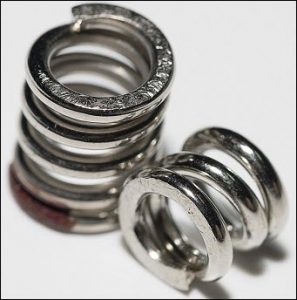What are Stainless Steel Compression Springs?
There are vast varieties of springs used today in a number of industrial and commercial applications. Among all the different types of springs, compression springs are considered to be the most efficient energy storage devices. This makes them ideal to be used in a wide range of application areas. They find their use in applications varying from ballpoint pen to various medical devices. These springs are made from helically formed coils. There is a pitch in between every coil. Whenever an external force or load acts on the springs and compress them, the pitch between the coils pushes the spring back to its original position. Thus, once the external force is removed, the compression spring regains its original shape.

On the basis of application, different materials are used to manufacture compression springs. However, stainless steel is the most preferred material, owing to its properties and several beneficial features.
Types and Properties of Stainless Steel Used in Compression Springs
Following are some types of stainless steel alloys that are widely used for manufacturing compression springs:
- Stainless Steel Type 631 (17-7 PH) – This material is known to perform well under adverse conditions, and have a long life. Thus, it is considered to be ideal for manufacturing springs. Compression springs that are manufactured using this material have following properties:
- Good ductility
- Superior fatigue properties
- Better strength-to-weight ratio
- Good corrosion resistant
- Great elasticity
- Excellent yield strength
- 300 Series Stainless Steel – These materials are also referred as austenitic stainless steel alloys. This alloy is made up of 10-20% nickel and 17-25% chromium. There are several benefits of using this alloy for compression springs. The springs produced from this alloy has its own set of beneficial features as follows:
- Excellent toughness
- Outstanding ductility
- High resistance to corrosion
- Non-magnetic
- Stainless Steel Type 301 – This alloy is composed of 7% nickel and 17% chromium. This material is best suited to drawing, forming, as well as welding. When you decide to go with this material for manufacturing the compression springs you need, then you get to see following beneficial features of stainless steel type 301:
- Highly resistant to corrosion
- Excellent tensile strength
- Good ductility
- Non-magnetic in annealed condition
- Magnetic after cold deformation
- Stainless Steel Type 302/304 – These alloys are made from 8% nickel and 18% chromium. This austenitic alloy is most popular and widely used in the entire stainless steel family. Several beneficial features of these alloys make them suitable to use in compression springs. Here are some striking properties of these alloys:
- Outstanding formability
- Highly resistant to oxidation
- High strength with low weight
- Great toughness
- Good strength at cryogenic temperatures
- Stainless Steel Type 316 – This material is almost identical to stainless steel 302, when it comes to heat resistance and physical properties. These alloys are used in compression springs for the following beneficial features that they offer:
- Better corrosion resistance compared to type 302/304 alloys
- Excellent cold forming properties
All these properties of the stainless steel variants make the stainless steel compression springs popular in various industries and applications.

 Upload Your CAD Drawing
Upload Your CAD Drawing